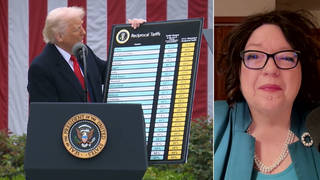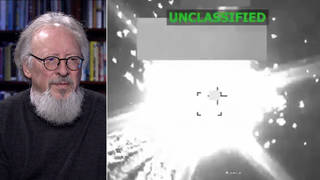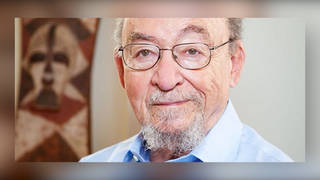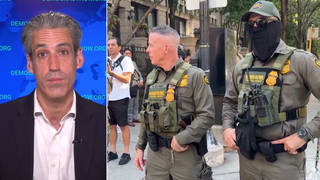
Newly released FBI documents reveal how the Nixon and Reagan administrations used the FBI to intimidate witnesses set to testify against the late Chief Justice William Rehnquist at his confirmation hearings. The documents also reveal Rehnquist’s dependency on pain medication once led him to try to escape a hospital stay in his pajamas after convincing himself of a CIA plot against his life. We speak with the reporter who broke the story. [includes rush transcript]
Transcript
JUAN GONZALEZ: Newly released FBI documents reveal dramatic details about former Chief Justice William Rehnquist’s two confirmation battles and his 1981 hospitalization and dependence on a painkiller. The documents show that both the Nixon and Reagan administrations ordered the monitoring of witnesses set to provide testimony critical of Rehnquist during his 1971 and 1986 confirmation process.
The documents also reveal that during Rehnquist’s 1981 hospital stay, doctors reported that he exhibited severe withdrawal after he stopped receiving the highly toxic drug Placidyl. Rehnquist was said to have had hallucinations and once tried to escape from the hospital in his pajamas after convincing himself of a CIA plot against his life.
AMY GOODMAN: The FBI released 1,561 pages of documents on Rehnquist in response to requests made under the Freedom of Information Act following Rehnquist’s death in September of 2005. They’ve withheld an additional 200 pages in the file and say one entire section cannot be retrieved.
Tony Mauro is with us now from Washington, D.C. He is the Supreme Court correspondent for Legal Times. Tony was the reporter who filed the Freedom of Information Act requests on Rehnquist. Juan?
JUAN GONZALEZ: Well, Tony, tell us some of the key findings that you’ve been able to discern already from reviewing some of these pages.
TONY MAURO: Well, as you were mentioning, while these files always tell you a lot about the FBI, as much about the FBI as about the person in the file, and so we do see in both 1971 and 1986 the FBI being used by the Justice Department, first the Nixon Justice Department and then the Reagan Justice Department, 1986, as a research tool to find out what potential witnesses were going to say about Rehnquist at his confirmation hearings. And certainly in 1971 there’s a big OK from J. Edgar Hoover, so this was approved at the top. You have to think that when an FBI agent comes to the home of a potential witness and starts asking, “What are you going to testify about?” that has to be intimidating. So, you see in this file, as with many others over the years, the FBI being used in a political way to discourage or at least find out about potential adversaries of the administration.
JUAN GONZALEZ: I was struck particularly — I interviewed yesterday Alexander Charns, the North Carolina lawyer who also participated in the battle to get these records, and he sent me over some of the more damaging memos. But I was particularly struck by the degree to which the FBI was being used for partisan — basically partisan political purposes. Some of the memos, apparently they indicate that back on July 30th of '86, just as the hearings were going on over Judge Rehnquist's nomination as chief justice, all of the conversations back and forth between John Bolton, who was then at the Justice Department, and several other justice officials insisting that they wanted to know exactly what every witness critical of Rehnquist was going to say before they actually appeared at the hearings.
TONY MAURO: That’s right. And you notice in that memo in 1986 that there was at least one FBI agent, whose name is blocked out, who raised a flag and said, “You know, if we do this, the Democrats are going to say that the Republicans are abusing the FBI again. Are you sure you want to go ahead with this? This is sort of a touchy area.” And you do have in that memo indication that John Bolton — it went up to John Bolton, who was then assistant attorney general, and he gave the OK, and he said, “You know, if there’s any controversy about our use of the FBI in this way, I’ll take responsibility.” So at least there was some awareness this was a touchy area, but it still shows you that even as recently as 1986, the FBI was being used in this way.
AMY GOODMAN: Let’s talk about 1986 and what the people who were testifying against the confirmation of Justice Rehnquist as Chief Justice were saying, back to the time in Arizona when Rehnquist was an attorney and a Republican poll watcher, talking about the issue of intimidation of minority voters. That was going to be their testimony. What was his involvement with that?
TONY MAURO: Well, in those hearings in 1986, there were very credible witnesses who said that he was part of an intimidation effort against minority voters. What you see in the FBI file is a very extensive investigation into those allegations. The FBI seemingly interviewed almost everybody who was a Republican or a Democratic official in that period time of 1962-1964 to see what they remembered about Rehnquist.
And it’s kind of a mixed picture. Some of the people they interviewed said Rehnquist wasn’t even there, others said that he had a very minor role or that he was a mediator, in fact. But I think the FBI did conclude that there were at least some conversations at polling places, where Rehnquist was talking to other Republican officials in a loud voice about the requirements that voters must have in order to vote, and that as a result of those conversations, several minority voters got out of line and went home.
But in contrast to these files, certainly, there was considerable testimony, live testimony, at the Senate Judiciary Committee, indicating that he had a much more active role.
JUAN GONZALEZ: Some of those who testified — one was James Brosnahan who was a former assistant U.S. attorney for the Civil Rights Division, who actually saw Rehnquist in a polling place where a lot of complaints had been lodged, and he was the main challenger. There was also a state senator by the name of Manuel Pena, who’s actually mentioned in those memos, who claims that he saw Rehnquist challenging voters. And also a — I think it was a Professor Sidney Smith, a sociology professor and Democratic poll watcher who said he personally saw Rehnquist challenging black voters and accusing them of not being able to read, therefore telling them to leave the lines. But Pena is specifically mentioned in these memo as a person apparently who the Justice Department wanted the FBI to interview.
TONY MAURO: Well, that’s right. There are a few of the people interviewed by the FBI are named, but most of them are not. So it’s not even clear that they interviewed Brosnahan, but, as you say, he did testify very strongly at the hearings.
AMY GOODMAN: And then there’s the issue of the covenant, the stipulation on the — what would you call it?
TONY MAURO: The deed.
AMY GOODMAN: The deed of his home, of Rehnquist’s home, that you could not sell the home — you could only sell it to a white person. What was the knowledge of the FBI at the time?
TONY MAURO: Well, they seem to know that, and there was also — there’s a covenant —- it was a covenant, I believe, on his home in Vermont. He had a summer home in Vermont, that said that it could not be sold to anybody of the Hebrew race. And those covenants, racial and ethnic covenants, were fairly common in properties in the early 20th century. This did come out during the hearings, and Rehnquist said he was unaware of them. These FBI files suggest that he may have been more aware than he let on. But it was true that -—
AMY GOODMAN: Interestingly, also wasn’t it that the FBI found out about the covenant during their '71 investigation, but didn't reveal it until the ’86 confirmation hearings, right?
TONY MAURO: I think that’s right. I don’t recall that that came up in '71 in the ’71 hearings, but his answer, Rehnquist's answer was that these covenants were not enforceable anyway, and so they weren’t really a big issue.
AMY GOODMAN: Finally, Tony Mauro, the issue of Judge Rehnquist’s dependence on drugs, on prescription drugs, particularly Placidyl, talk about that.
TONY MAURO: Well, it was pretty remarkable to read this. Certainly, this was made public at the time. When he went into the hospital in 1981 with withdrawal symptoms, there was an announcement or a disclosure of why he was there. It said he had developed a drug dependence. But these files give much more detail and suggest that he was using this very powerful drug for at least 10 years during his tenure as an associate justice, and that in the six months before he was in the hospital in 1981, he had actually been filling three-month prescriptions every month, suggesting that he was taking three times the normal dosage of this drug.
AMY GOODMAN: And what did it cause? What happened? Describe the incident they describe at George Washington Hospital?
TONY MAURO: Well, he did have delusions, apparently, and he did claim there were CIA plots against him, and I guess this is typical withdrawal symptoms from this drug. I was covering the court at the time in 1981, and I do recall another journalist who covered the court recall that he was slurring his words during oral arguments on the bench, and there was some visible impact, but everybody who has talked about it says that the impairment was minor and that he was able to function fully as a justice.
AMY GOODMAN: And this issue of believing the CIA wanted to kill him?
TONY MAURO: Yes, interestingly, his wife, I believe, was an employee of the CIA, Rehnquist’s wife. And the idea that he was seeing conspiracies out there was pretty remarkable.
AMY GOODMAN: It’s amazing that this didn’t get out at the time, when he was running in the hospital in his pajamas, believing the CIA would kill him, considering there’s orderlies, there’s nurses, there’s doctors, this big staff. This is a big hospital at George Washington Hospital.
TONY MAURO: That’s right. No, I think there’s this sort of a circle of wagons attitude, and they don’t disclose these things. Again, this was raised during — not these dramatic details, but his drug dependence was raised during the 1986 confirmation period, but the Republicans kept this FBI file from being made public, and it never came up during the hearings.
AMY GOODMAN: Well, Tony Mauro, we want to thank you very much for being with us, Supreme Court correspondent for the Legal Times, broke the story on the documents now released by the FBI, gotten under Freedom of Information Act request. We’ll link to your story, as well as, Juan, your story in today’s New York Daily News, “G-Men Were Used to Quell Justice’s Critics.”











Media Options